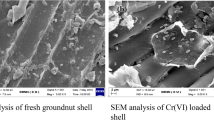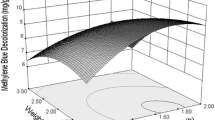Abstract
Cu(II) adsorption in continuous column using green adsorbents like peanut and almond shell was investigated. Fourier transform infrared (FTIR) spectroscopy, Brunaer-Emmett-Teller (BET) analysis, scanning electron microscopy (SEM), and Point of Zero charge (pHpzc) determination have been used for characterization of the adsorbents. Experiments were conducted at various operating conditions to calculate the adsorption capacity of the adsorbents. Adsorption studies signify that both the adsorbents have good adsorptive capacity for Cu(II) ion. Equilibrium of adsorption was described using Langmuir isotherm and the highest qmax value for both the adsorbent were obtained at an operating condition of 20 ml/min flow rate, 15 mg/L influent Cu(II) concentration, and 7 cm bed depth. Regeneration of both the adsorbents suggests that these adsorbents can be used several times for Cu(II) removal. Seven different kinetic models were tested among which the modified dose response model was fitted well for peanut shell and the Thomas model was fitted well for almond shell. These fitted models were further used for scale-up design. Regeneration studies show that peanut shell and almond shell are useful up to the fifth adsorption cycle. Application of these adsorbents with industrial effluent was also reported. This study reveals that peanut and almond shells can be used for Cu(II) removal for industrial wastewater.












Similar content being viewed by others
Abbreviations
- a :
-
parameter of modified dose response model
- C 0 :
-
influent concentration of Cu(II) (mg/L)
- C d :
-
discharge limit of Cu(II) for inland surface water (mg/L)
- C t :
-
Cu(II) concentration in effluent at time t (mg/L)
- C eq :
-
equilibrium concentration of metal ion (mg/L)
- C w :
-
Cu(II) concentration in waste water (mg/L)
- D :
-
diameter of the adsorption column (m)
- d ad :
-
density of the adsorbent (kg/m3)
- H :
-
total bed height in the column (m)
- H c :
-
additional height for accessories (m)
- K B :
-
rate constant (L/(mg.min))
- K L :
-
kinetic constant of Langmuir isotherm (L/mg)
- K Y :
-
kinetic rate constant of Yan et al. model (ml/(mg.min))
- k AB :
-
kinetic rate constant of Bohart-Adams model (L/(mg.min))
- k Th :
-
kinetic rate constant of Thomas model (ml/(mg.min))
- k YN :
-
kinetic rate constant of Yoon-Nelson model (min-1)
- M ad :
-
designed adsorbent mass (kg/day)
- m :
-
mass of the adsorbent (g)
- m total :
-
amount of Cu(II) ion sent to the column in total (mg)
- N 0 :
-
saturation concentration (mg/L)
- N :
-
number of experimental points run
- Q :
-
volumetric flow rate (ml/min)
- Q d :
-
Designed volumetric flow rate (ml/min)
- q 0 :
-
Thomas model adsorption capacity (mg/g)
- q 0(exp) :
-
experimental adsorption capacity (mg/g)
- q 0(cal) :
-
adsorption capacity calculated using theoretical kinetic models (mg/g)
- q ad :
-
adsorptive capacity of the adsorbent as per best fitted model (mg/g)
- q Y :
-
Yan et al. model maximum adsorption capacity (mg/g)
- q exp :
-
equilibrium Cu(II) uptake (mg/g)
- q max :
-
adsorption capacity (maximum) (mg/g)
- q mdr :
-
Modified dose response model adsorption capacity (mg/g)
- q total :
-
total Cu(II) adsorbed (mg)
- q R :
-
amount of Cu(II) adsorbed after regeneration (mg)
- R 2 :
-
correlation coefficient, dimensionless
- T :
-
working time (hr)
- t :
-
time (min)
- t R :
-
bed regeneration time (min)
- t RS :
-
bed saturation time after regeneration (min)
- t b :
-
breakthrough time (min)
- t e :
-
exhaustion time (min)
- t total :
-
flow time in total (min)
- U 0 :
-
superficial velocity (cm/min)
- V eff :
-
volume of effluent (L)
- W:
-
wastewater rate (L/day)
- Z :
-
bed depth (cm)
- SE:
-
standard error, \( SE=\sqrt{\sum \frac{{\left({q}_{0\left(\mathit{\exp}\right)}-{q}_{0(cal)}\right)}^2}{N}} \)
- β :
-
external mass transfer kinetic coefficient of Wolborska model (min-1)
- τ :
-
breakthrough time at 50% (min)
- ε :
-
regeneration efficiency
References
Aber S, Salari D, Ayoubi Feiz B (2011) The sorption of copper on almond shell: optimization and kinetics. Water Sci Technol 63(7):1389–1395
Ahmari Z, Khosravi M, Niazi A (2015) Removal of Cu(II) from aqueous solution using dried activated sludge and dried activated nano-sludge: adsorption on a fixed bed column. Orient J Chem 31(2):933–938
Ahmed R, Haseeb S (2015) Competitive adsorption of Cu2+ and Ni2+ on Luffa acutangula modified tetraethoxysilane (LAP-TS) from the aqueous solution: thermodynamic and isotherm studies. Gr Water Sustain Dev 1:146–154
Ali RM, Hamad HA, Hussein Mo M, Malash GF (2016) Potential of using green adsorbent of heavy metal removal from aqueous solutions: adsorption kinetics, isotherm, thermodynamic, mechanism and economic analysis. Ecol Eng 91:317–332
Altun T, Pehlivan E (2007) Removal of Copper(II) ions from aqueous solutions by walnut, hazelnut and almond shells. Clean Soil Air Water 35(6):601–606
Aman T, Kazi AA, Sabri MU, Bano Q (2008) Potato peels as solid waste for the removal of copper(II) from waste water/industrial effluent. Colloids Surf B: Biointerfaces 63:116–121
Banerjee M, Bar N, Basu RK, Das SK (2017) Comparative study of adsorptive removal of Cr(VI) ion from aqueous solution in fixed bed column by peanut shell and almond shell using empirical models and ANN. Environ Sci Pollut Res 24:10604–10620
Banerjee M, Bar N, Basu RK, Das SK (2018) Removal of Cr(VI) from its aqueous solution using green adsorbent pistachio shell: a fixed bed column study and GA-ANN modeling. Water Conserv Sci Eng 3:19–31
Baral SS, Das N, Ramulu TS, Sahoo SK, Das SN, Chaudhury GR (2009) Removal of Cr(VI) by thermally activated weed SalviniaCucullata in a fixed bed column. J Hazard Mater 161:1427–1435
Bharthare P, Shrivastava P, Singh P, Tiwari A (2014) Peanut shell as renewable energy source and their utility in production of ethanol. Int J Adv Res 2(4):1–14
Bhattacharyya KG, Gupta SS (2011) Removal of Cu(II) by natural and acid-activated clays: an insight of adsorption isotherm, kinetic and thermodynamics. Desalination 272:66–75
Bishnoi N, Bajaj M, Sharma N, Gupta A (2004) Adsorption of Cr(VI) on activated rice husk carbon and activated alumina. Bioresour Technol 91:305–307
Bohart GS, Adams EQ (1920) Behaviour of charcoal towards chlorine. J Chem Soc 42:523–529
Chowdhury ZZ, Hamid SBA, Zain SM (2015) Evaluating design parameters for breakthrough curve analysis and kinetics of fixed bed columns for Cu(II) cations using lignocellulosic wastes. BioResources 10(1):732–749
Community data of Govt. of India. Available in https://community.data.gov.in/groundnut-production-of-various-states-in-2015-16/. Accessed on 8 Jan 2018
Environmental Protection Rules, (Schedule VI) of Central Pollution Control Board, Govt. of India (1986). Available: cpcb.nic.in/GeneralStandards.pdf. Seen on 27th Sept 2017
Han R, Zou W, Li H, Li Y, Shi J (2006) Copper (II) and Lead(II) removal from aqueous solution in fixed bed columns by manganese oxide coated zeolite. J Hazard Mater B137:934–942
Hasfalina CM, Maryam RZ, Luqman CA, Rashid M (2012) Adsorption of copper(II) from aqueous medium in fixed bed column by kenaf fibers. APCBBE Proc 3:255–263
GAIN Report no.IN7113 dated 20.9.2017. Available on https://gain.fas.usda.gov/Recent%20GAIN%20Publications/Tree%20Nuts%20Annual_New%20Delhi_India_9-20-2017.pdf. Accessed on 8.2.2018
Georgaka A, Spanos N (2010) Study of the Cu(II) removal from aqueous solutions by adsorption on titania. Glob Nest J 12(3):239–247
Indian Standards for Drinking water (IS 10500:2012) Available on http://cgwb.gov.in/Documents/WQ-standards.pdf. Accessed on 27 Sept 2017
Kafshgari F, Keshtkar AR, Musavian MA (2013) Study of Mo(VI) removal from aqueous solution: application of different mathematical models to continuous biosorption data. Iranian J Environ Health Sci Eng 10(1–11):14
Kyzas G, Kostoglou ZM (2014) Green adsorbents for wastewaters: a critical review. Materials 7:333–364
Langmuir I (1918) Theadsorption of gases on plane surfaces of glass, mica and platinum. J Am Chem Soc 40:1361–1368
Larous S, Meniai AH, Lehocine MB (2005) Experimental study of the removal of copper from aqueous solutions by adsorption using sawdust. Desalination 185:483–493
Lin X, Li R, Wen Q, Wu J, Fan J, Jin X, Qian W, Liu D, Chen X, Chen Y, Xie J, Bai J, Ying H (2013) Experimental and modeling studies on the sorption breakthrough behaviors of butanol from aqueous solution in a fixed bed of KA-I resin. Biotechnol Bioprocess Eng 18:223–233
Malkoc E, Nuhoglu Y, Dundar M (2006) Adsorption of chromium(VI) on pomace—an olive oil industry waste: batch and column study. J Hazard Mater B138:142–151
Misra V, Balomajumder C, Agarwal VK (2013) Adsorption of Cu(II) on the surface of nonconventional biomass: a study on forced convective mass transfer in packed bed column. J Waste Manag. https://doi.org/10.1155/2013/632163
Shanmugam D, Alagappan M, Rajan RK (2016) Bench-scale packed bed sorption of Cibacron blue F3GA using lucrative algal biomass. Alex Eng J. https://doi.org/10.1016/j.aej.2016.05.012
Singha B, Das SK (2011) Biosorption of Cr(VI) ions from aqueous solutions: kinetics, equilibrium, thermodynamics and desorption studies. Colloids Surf B: Biointerfaces 84:221–232
Singha B, Das SK (2013) Adsorptive removal of Cu(II) from aqueous solution and industrial effluent using natural/ agricultural. Colloids Surf B: Biointerfaces 107:97–106
Srivastava VC, Mall ID, Mishra IM (2006) Characterization of mesoporous rice husk ash (RHA) and adsorption kinetics of metal ions from aqueous solution onto RHA. J Hazard Mater 134:257–267
Thomas HC (1944) Heterogeneous ion exchange in a flowing system. J Am Chem Soc 66(10):1664–1666
Witek-Krowiak A, Szafran R, Modelski S (2011) Biosorption of heavy metals from aqueous solutions onto peanut shell as a low-cost biosorbent. Desalination 265:126–134
Wolborska A (1989) Adsorption on activated carbon of p-nitrophenol from aqueous solution. Water Res 23:85–91
Yan GY, Viraraghavan T, Chem M (2001) A new model for heavymetal removal in a biosorptioncolumn. Adsorpt Sci Technol 19:25–43
Yoon YH, Nelson JH (1984) Application of gas adsorption kinetics II. A theoritical model for respirator cartridge service life. Am Ind Hyg Assoc J 45:509–516
Acknowledgements
The authors are gratefully acknowledging the Department of Science & Technology, West Bengal (Sanction No.: 21(Sanc)/ST/P/S&T/13G-1/2013 dt. 06.06.2014) for providing the research fund.
Author information
Authors and Affiliations
Corresponding author
Additional information
Responsible editor: Guilherme L. Dotto
Rights and permissions
About this article
Cite this article
Banerjee, M., Basu, R.K. & Das, S.K. Cu(II) removal using green adsorbents: kinetic modeling and plant scale-up design. Environ Sci Pollut Res 26, 11542–11557 (2019). https://doi.org/10.1007/s11356-018-1930-5
Received:
Accepted:
Published:
Issue Date:
DOI: https://doi.org/10.1007/s11356-018-1930-5




